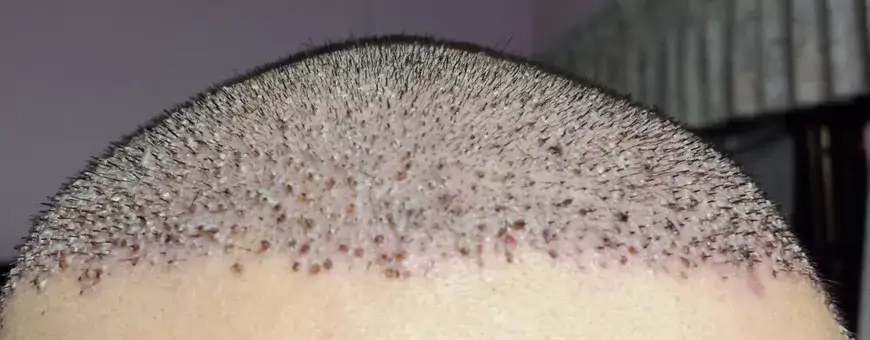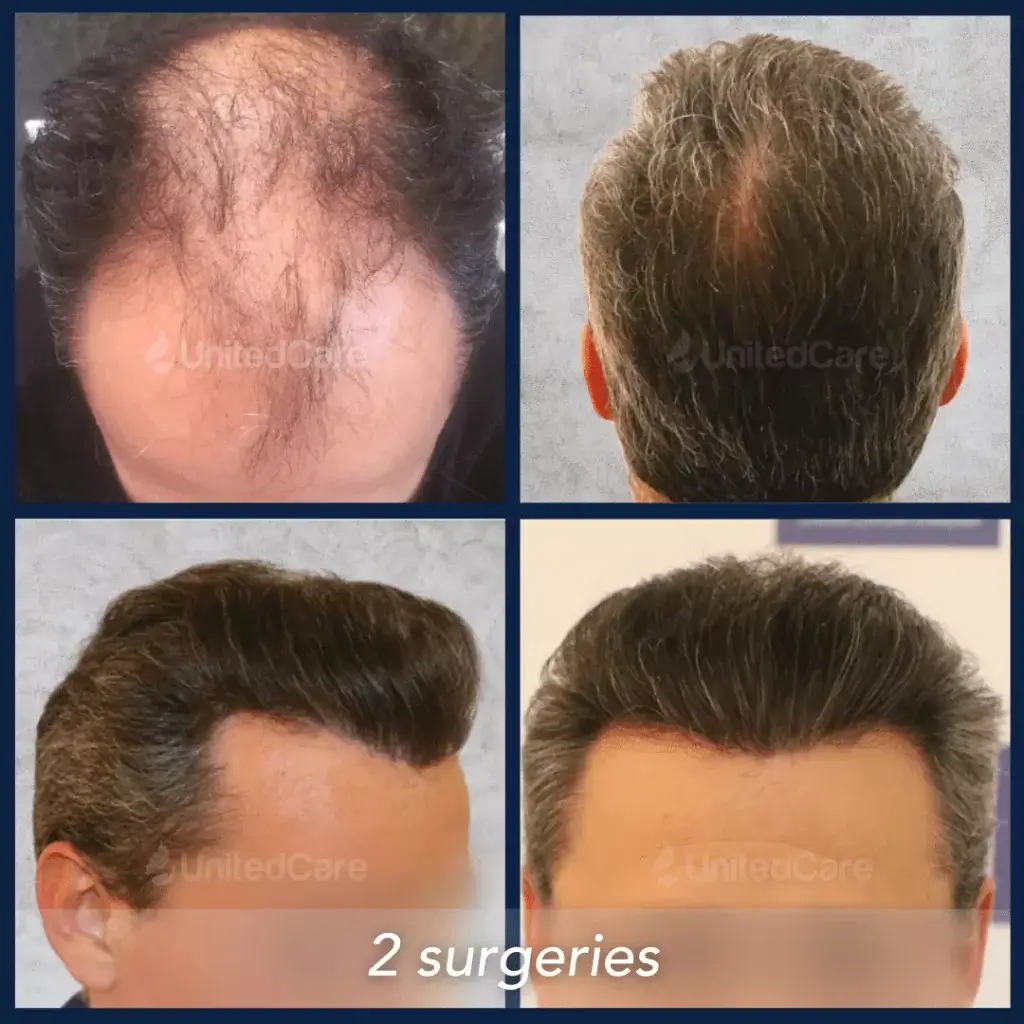One important question for you: Are you having second thoughts?
When talking about the advantages and safety of a hair transplant, any clinic can ensure you with positive rates.
However, we believe that a patient deserves a balanced amount of comfort and health.
Thus, you must know the potential scenarios for not wanting to get a hair transplant before you make up your mind.
Also, after we clear all the reasons, you can see how eligible you are for a transplant and why some balding people do not get one.
So, in today’s article, I will explain why most people do not get a hair transplant, what are its dangers exactly to cause disbelief, and when you should get one:
Table of Contents
Let’s first understand why despite all of its benefits and low rate of risks, most people do not get a hair transplant:
Why Do Most People Not Get Hair Transplants?
With such various advanced techniques and supplements, modern hair transplants have become an efficient solution against male pattern baldness.
However, when you go out to the streets, even in today’s world, you still see many people with advanced androgenetic alopecia walking around.
So, why is it that most of these people do not get a hair transplant?
Typically, there are 6 main reasons for that:
1️⃣ Not fitting into the criteria: Not everyone can be a good candidate for a hair transplant. You must match specific requirements to be eligible for a transplant, such as having enough hair follicles in your head or fitting the ideal age gap.
2️⃣ Old techniques create prejudice: Hair transplants and dermatology have an old history. And since their first cases appeared many years ago, there has been a prejudice about their effectiveness. However, this is false. This bad publicity exists due to the old techniques used many years ago called hair plugs. This technique is quite ancient and is not in use, so its ineffective and dangerous approach is long gone. The current modern methods are much more advanced, effective, and safe.
3️⃣ Bad publicity gets more attention: I have said that since hair transplants started many years ago, its history has had ineffective and outdated methods that still affect people’s prejudice today. One another part of this that causes people not to get a transplant is that despite how much time passes, these ineffective or failed transplants always get more attention. Today, we have more cases of success in our field, but as competition increases now and then, some low-quality clinics emerge. And as always, people rarely share successful hair transplants in their stories, while failed or bad transplants get more publicity.
4️⃣ Family history creates disbelief: Male pattern baldness is common, appearing in 50% of patients by age 50, according to studies. As genetically transmitted androgenetic alopecia is highly common, some patients grow up with a family of balding relatives. Overall, this leads to them believing that a hair transplant may not be enough to save them and grant them a better future. But this decision, ultimately, should be taken with a doctor’s consultation.
5️⃣ Post-surgery care seems like too much work: Maintaining healthy hair and ensuring hair loss never becomes an issue after surgery is hard work. Some patients see transplants as a hopeless struggle when mixed with their prejudice towards the transplant’s success and their disbelief due to their genetic background. We believe otherwise. With such powerful supplements and guidelines on what to do post-transplant, any right candidate can maintain their newly transplanted hair and the existing one safe from the effects of hair loss, along with their doctor’s help.
6️⃣ The potential risks, side effects, and disadvantages seem scary: We believe that ultimately, this factor, too, should not affect your judgment alone and must be considered with your doctor’s consultation. However, it is true that despite all of them being uncommon, they are still possible scenarios.
So, you should know them beforehand:
Top Dangers and Disadvantages of Hair Transplants
When it comes to the dangers of disadvantages of hair transplants, you have two categories to face:
➡️ Unpleasant disadvantages of a hair transplant exist in every surgery, such as the necessary recovery time or discomfort.
➡️ Uncommon yet possible dangers of a hair transplant, such as scarring, infection, and other side effects.
Let’s go over them one by one:
1- Scarring
Hair transplant scars appear at the final stages of your recovery post-surgery.
👉 Let’s clarify this: As of 2023, no hair transplant surgery is “entirely scarless.”
Even though the newest hair transplant techniques have drastically reduced scars, some will still be left.
So, the technique you choose is an essential factor.
In FUE surgeries, tiny scars remain in the donor area after the follicles are harvested. These scars aren’t noticeable for most patients unless they are closely examined.
But, It’s a whole other story in FUT surgeries:
⚠️ The biggest downside of FUT surgeries compared to their better alternative, FUE, is undoubtedly the linear scar caused by strip transplants.
In a FUT surgery, the surgeon cuts a strip of tissue from the donor site, which holds the needed amount of hair grafts for the hair transplant.
Then, hair follicles are extracted from this separated tissue.
➡️ As the harvesting is done in a much more concentrated area and the skin tissue is extracted with the hair follicles, this extraction site leaves a scar.
This linear scar is, unfortunately, easily noticeable. So, most FUT patients have to grow their hair to a certain degree to hide it.
🍀 So, ultimately, this side effect is avoidable by choosing the right clinic.
2- Infections
Like any other surgery with skin penetration, hair transplants have a chance to cause an infection in the area of surgery.
💡 The rate for it, however, is extremely low, appearing in only 1% of all patients.
These infections are usually mild and can be easily treated with antibiotics and regular scalp washing.
However, if it progresses further, an infection can cause the transplanted hair follicles to fall out and radically affect the effectiveness of the operation.
And if it goes untreated longer than that, it can spread deeper into the scalp tissue and bones, causing numerous diseases that could prove vital such as septicemia.
That is why you should pay attention to the early signs of a hair transplant infection.
⚠️ The top signs of a hair transplant infection are excessive redness and discoloration on the scalp, drainage, and a burning sensation.
The key word here is excessive. Because some amount of redness is expected and natural due to other side effects, such as bleeding or leaving scabs, which brings us to the following scenario:
3- Leaving scabs, crusts, or bleeding

During surgery, your scalp experiences some physical trauma, and, as a reaction, it lets through various fluids such as blood and edema.
These liquids quickly dry up after release and remain as scabs or crusts on your scalp.
The whole process is your body’s natural healing process and is the same as the crust forming around a wound when you injure yourself.
⚠️ The critical part to focus on is scabs after a hair transplant should soften up and fall out a few days after the surgery, but you should consult your dermatologist if they are still solid around a week after the surgery.
One side note is that itching is another potential side effect that comes along with the crust.
It is expected and natural because the scabs and crust will form around the surgery site.
The itching should go away once the recipient and donor areas are healed, which should also take around a week.
🔔 During that, you shouldn’t scratch your scalp or pick scabs under any circumstance since it’ll only worsen the situation, harm the healing process, and risk infections and poor results.
4- Swelling
Alternative to the previous scenario, if those bodily fluids cannot be properly released, you may experience swelling.
💡 A swelling usually appears around the forehead, eyelids, and face. Also, it may come with inflammation in the areas where your body is trying to release fluids.
It can begin 2-3 days following the surgery, as a ton of edema is produced in response to the micro-trauma caused by the incisions made during the surgery.
💠 But it shouldn’t last longer than 3 days on average.
Unfortunately, swelling differs drastically between patients.
⚠️ Some patients’ bodies can react mildly with minimal pain or severely with throbbing pain around their faces. But some might even have a hard time opening their eyelids. That is why it is harder to determine whether it is natural or due to an allergic reaction such as Anaphylaxis.
So, ideally, you should regularly follow your post-surgery check-ups to ensure that your doctor can take precautions early if necessary.
5- Hair rejection and shock loss
I have mentioned that an unnoticed and advanced level of infection can cause your transplanted hair follicles to fall out.
But this is a rare side effect not getting medical attention.
There are, however, two cases of complications when a hair transplant goes wrong that can also cause hair loss after surgery:
1️⃣ Hair rejections
2️⃣ Shock loss
Both are excessive hair loss scenarios, but shock loss is a natural reaction, while hair rejections are due to a failed hair transplant.
Hair transplant rejections appear due to poor hair treatment during and after the surgery.
The main reasons usually are either the patient not regularly caring for their hair post-surgery (because their clinic did not inform them) or the clinic not paying proper attention.
⚠️ A hair transplant process is not limited to surgery alone, and entrusting your hair’s future to a clinic that believes it is, can cost you a lot.
👉 So, once again, your key to survival in this scenario is choosing the right clinic through background research.
On the other hand, shock loss is an expected side effect.
Your scalp goes through severe stress during and following a hair transplant surgery as it experiences both incisions for retrieving and insertion.
Naturally, your body reacts to this stress, and in most cases, this reaction comes in the form of a sudden hair loss in the recipient area a few weeks following the surgery, which we call shock loss.
💠 But, for almost all cases, shock loss isn’t permanent, and new hair grows in the place of the fallen grafts.
In a few months, commonly around 6-8 months after the surgery, your new hair that fell out during shock loss too should grow and mature, contributing to your natural look.
🩺 Of course, it is always safest to regularly track your hair regrowth with your doctor.
6- Pain and discomfort
Naturally, with this many reactions happening one after the other in your scalp, you will expectedly experience some pain.
💉 But your experience of hair transplant pain during surgery will be minimal, and even then, we can eliminate it by using anesthesia.
After that, you will again experience pain, tightness, and overall discomfort around your scalp the first few days following the surgery.
🍀 This is due to your body’s initial healing process.
But painkillers are prescribed mainly for this period, so you will not experience much during these days.
Once you’re off the painkillers, you should still expect some pain and discomfort, but it is mild for most patients.
⚠️ If the pain persists, however, you can continue with over-the-counter painkillers after consulting your doctor.
The overall pain experience can turn to numbness after surgery, depending on your body’s reaction or the persisting effects of anesthesia. But this, too, should not last longer than a few days.
🔔 Another crucial point is that your pain can vary depending on your hair transplant method.
Most patients commonly experience higher pain in FUT, where grafts are harvested from a strip of tissue cut from the scalp.
👍 So, going for more modern and effective techniques such as DHI or Sapphire FUE can help you achieve a more pain-free smooth process.
7- Recovery Time
Finally, the last reason is an odd and relatively mild disadvantage of hair transplants. However, some patients still care about it: The recovery time of the surgery.
As I mentioned before, the whole hair transplant process does not include surgery alone. And similarly, defining the transplant as a success or a failure works the same way.
Based on that, a hair transplant is seen as successful only if most transplanted hair follicles have survived after recovery.
Ultimately, although the recovery time can be long and tedious, it is vital to your transplant. And generally, this period is 6 to 12 months. And even after that, your care towards your transplanted hair must remain if you want to maintain it.
So, now that you know why some people do not get a hair transplant and what might happen if you do, the question is, should you and when?
When Should You Get a Hair Transplant 🥼
The first question is simple.
You should get a hair transplant only if you are ready and fit to get one.
So, when should you get one?
Well, we have our conditions for that.
Let’s see if you fit them:
💠 The number of hair follicles on your scalp: Hair transplants require follicles, so the number of hair follicles from the healthy areas you have in your head that are not affected by male pattern baldness will heavily influence the outcome. The average number of grafts harvested in a hair transplant surgery is approximately 2000. For best results, however, your donor area should be at least equal to the balding area.
💠 Staying within the ideal age gap: In some cases, we can guess that patient’s body will likely reject the hair transplant after the surgery based on biological factors such as age. As we said earlier, there is no definitive age you need to pass to be eligible. However, we can determine an age gap based on the universal success rates of patients and the hair regrowth process of your body that changes throughout your life. So, ideally, patients between the ages of 25-65 are best suited for this operation, as age strongly affects whether your hair is thick enough to survive the transplant.
💠 Having an advanced balding area on your scalp: A hair transplant is best suited for patients who show a clear sign of developed baldness rather than patients who are at the early ages of their hair loss. There are several signs to look for to understand whether your hair is balding, such as seeing your scalp in the mirror, changing hair lines, and losing more hair than usual every day.
If you believe these conditions match your current situation, you might be perfect for getting a hair transplant.
So, let’s not wait any longer:
Get a free consultation now to know for sure 🍀

At UnitedCare, we begin your hair transplant process by offering you a free one-on-one consultation with our expert doctors to find the best-suited option together.
Our holistic approach provides you with a mix of advanced technologies and bio-enhancements to ensure you do not need another surgery.
After you have decided on a method, we begin the treatment with the utmost attention. But most importantly, we stay in contact with our patients even long after the surgery has finished, ensuring that your transplant becomes permanent.
Affordable hair transplant costs, a holistic approach, and experienced dermatologists on-site are here to provide you with the right solution.
Ready to begin the journey? Click here to start the first step with a free consultation:
Reach out now to get a doctor’s view on your balding areas.
And if ready, restore your natural look with a Dermatosurgeon:
Frequently Asked Questions (FAQs)
Why don’t all bald people get hair transplants?
Usually, the reason all bald people do not get a hair transplant can be seen in two categories. First, some people are prejudiced towards hair transplants due to the false things they have heard about old techniques or not believing in a hair transplant’s effectiveness due to the advanced balding gene in their family. And secondly, some fear the uncommon but still possible side effects such as infections or infections, or they simply do not fit the requirements for getting a hair transplant, such as having enough hair follicles left.
Why are hair transplants not recommended?
Hair transplants are very effective but advanced in our modern techniques to make them safer. But they are entirely for everyone. There are some requirements for being eligible to get a hair transplant, such as fitting the ideal age gap or having enough hair left on your head. So, doctors do not recommend a hair transplant for a patient that does not match them. Alternatively, some parts of the population have substantial prejudice towards hair transplants, which can cause them not to recommend it to others. But this is a mistake, as the reasons for these prejudices are generally misinformation or limited research.
In what cases should you not get a hair transplant?
It would be best not to get a hair transplant if you are at a very early age of hair loss. Similarly, if you wait too long, you may not have enough hair left on your head to undergo transplant surgery. Ultimately, getting a doctor’s consultation about your hair’s current state is best to see if it is the right time for a transplant.

